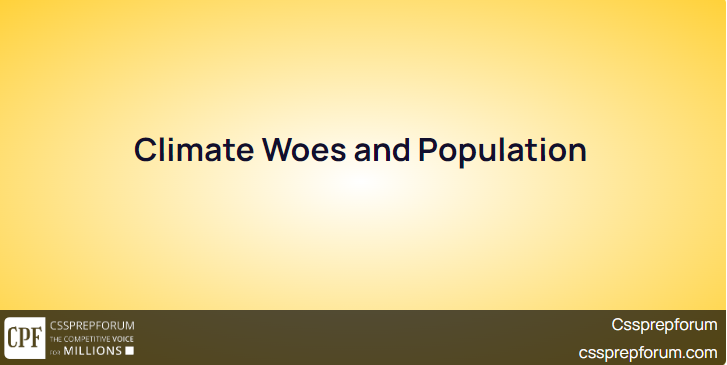Written By Shehroz Shaikh
Outline
- Global Climate Change
- International Community – Climate Woes and Population
- Developed Vs Non-Developed Countries
- The Case of Pakistan
- Sixth Most Populus Country
- Seventh Most Adversely Affected Country by Climate Change
- The Climatic Woes
- Floods
- Extreme Weather Events
- Melting Glaciers
- Disrupting Rainfalls
- Shortage of Water
- Availability of Water Vs. Population (Statistics)
- Some Important Concerns
- The Case of Bangladesh Vs. Pakistan (Population Comparision)
- Combating Climate Woes and Population
- Expanding Water Storage Capacity
- Water Conservation
- Reduce Unplanned Pregnancies
- Urgency in Implementation
- Conclusion
Few will contest that global climate change is a serious threat to the future of human welfare. And there is a plethora of suggestions regarding potential interventions to reduce greenhouse gas emissions, such as switching to renewable energy sources and making energy use more efficient.
But the international climate community is largely silent about the potential role of reducing population growth as a policy option that can improve the environment and bring many other health and socioeconomic benefits as well.
This silence may be understandable in the more developed countries that have seen sharply declining birth rates and where issues like aging populations are now of more concern.
But it has no place in developing countries like Pakistan, where environmental sustainability is threatened not only by growing climate risks but also by the pressures of a large and still fast-growing population.
Rising temperatures are disrupting rainfall patterns, melting glaciers, intensifying floods, and causing extreme weather events. But perhaps the most frightening environmental stress to emerge is the water shortage. We are already water scarce and the situation is projected to worsen over the next 20 years. Already, large parts of the country are affected by drought, which could spread and intensify with devastating consequences.
A few simple calculations confirm this. Total availability of water resources in Pakistan is currently estimated at around 178 billion cubic meters (BCM). With our current population size, this translates into 860 cubic meters (m3) per capita, a level indicating scarcity.
At an annual growth rate of 2.1pc, our population will expand to 246m by 2025 and over 300m by 2035. Unless we improve our ability to store and conserve water, per capita water availability will fall to 730m3 in 2025 and 590m3 in 2035.
Assuming we succeed in building the Diamer-Bhasha dam in time, it will add a precious 9.9 BCM to our water availability, but even then, due to population growth, per capita availability will only improve to around 770m3 in 2025 and 630m3 in 2035.
Regrettably, Pakistan’s population programme has shown very slow progress in this area. The results of the 2017 census indicate only a negligible decline in population growth over the last two decades, and the latest Pakistan Demographic and Health Survey 2017-18 results show hardly any change in fertility between 2007 and 2018.
A major factor in the neglect of population growth in climate change policy is the common perception that birth rates are not the responsibility of the government and cannot be changed by its intervention.
This outlook, which is especially prevalent among economists (including prominent experts in Pakistan) assumes that birth rates reflect actual demand for children, which is not the case.
Each year about 89m unintended pregnancies results in 30m unplanned births in the developing world among women who want to avoid pregnancy but are not using effective contraception.
The Population Council estimates that there are 4m unwanted pregnancies each year in Pakistan alone. Reasons for non-use of contraceptives include lack of access to services and the high costs of modern methods. Fear of side effects of methods, disapproval of husbands, and reluctance to violate social norms are also significant barriers to use.
Voluntary family planning programmes can reduce these obstacles by increasing access to contraceptives, providing subsidies, and expanding method options, thus contributing to sustained declines in fertility.

The potential impact of such programmes — and the fact that population growth can be reduced substantially, not through coercion, but simply by avoiding unplanned outcomes — is illustrated best by comparing Bangladesh and Pakistan.
The two countries had almost the same population size in 1980 when Bangladesh implemented one of the world’s most effective voluntary family planning programmes. In contrast, Pakistan’s programme has until recently been relatively feeble, lacking government funds and most of all commitment.
Not surprisingly, the population trajectories of the two countries have differed sharply since 1980. By 2100, Pakistan’s population is projected to be 178m more than Bangladesh. This difference will be attributable squarely to the success of the Bangladesh family planning programme.
For now, the government’s response seems focused on expanding water storage capacity. The Prime Minister and Chief Justice of Pakistan Fund for Diamer Bhasha and Mohmand Dam is a good initiative for improving our water security, but in the longer run, the country must adapt in a way that ensures equilibrium between future consumption and projected supply.
Water conservation in all sectors, domestic, agricultural, industrial, etc, is an important second avenue to prioritize. But even if we were able to implement and enforce good practices in time, the alleviation of scarcity would be short-lived unless the number of consumers also stabilizes.
Urgent efforts to reduce unplanned pregnancies and slow population growth must comprise the essential third prong for tackling the water crisis in Pakistan.
In the international discourse on climate change mitigation and adaptation, developed countries may be excused for wanting to avoid the awkward role of promoting voluntary family planning in developing countries: after all, it is the developed world that is primarily responsible for causing the climate to change through its excessive emission of greenhouse gases, and entering into a population policy discussion in the context of climate change might appear to blame the poor countries for problems created by the rich ones. But countries like ours, which are already facing the brunt of climate change, must focus urgently on what is a viable and affordable policy option for adaptation.
All of us who care about alleviating Pakistan’s water crisis, and ensuring its sustainable and equitable development — especially the new government — must prioritize the most obvious and inexpensive solution: focus on population welfare as a key to dealing with climate change stress.
For #CSS_2021 & #CSS_2022, top 100 Essays, Solved Past Papers from 2000 to 2020, and daily blogs, opinions, and articles like CSS Prep Forum.
If you know any teacher who can help students prepare any optional subject, such as political science, international relations, public administration, criminology, etc. then write for us. Moreover, if you have anything that can help students prepare for the CSS exam, kindly feel free to send us. We will publish so that we can collectively help hundreds of thousands of aspirants preparing for a successful future. Let’s get your stories published with us. Like & Follow us at Facebook & Instagram
Are you looking to learn English communication skills to qualify for the CSS and PMS English essay & Precis papers? Let’s join Sir Syed Kazim Ali and learn how to give your ideas and thoughts words, fluently and confidently.
CSS & PMS 2024 Extensive English Course













